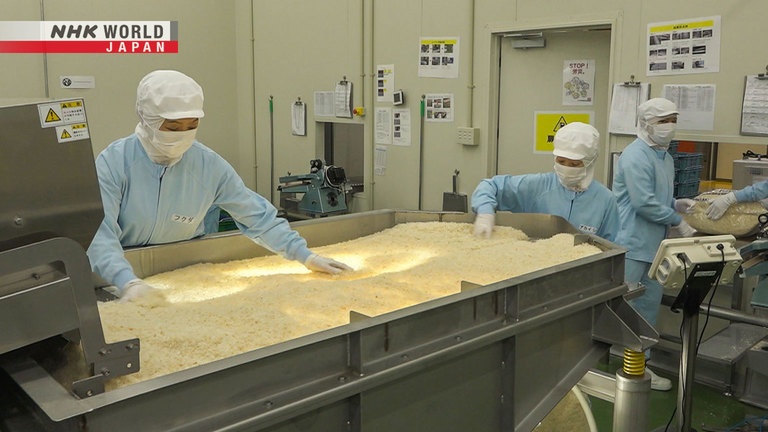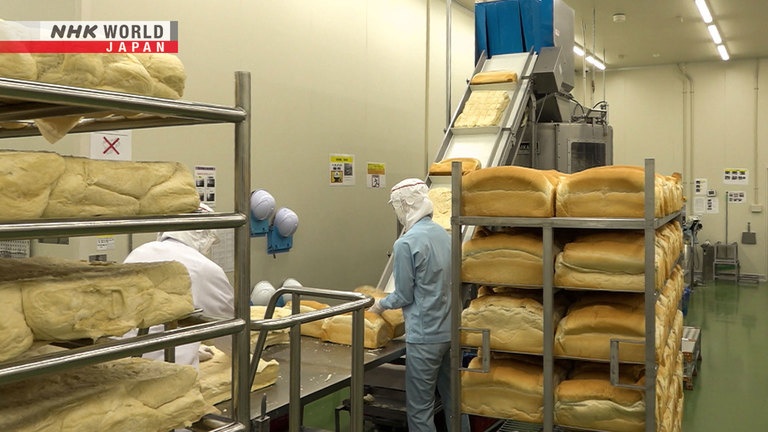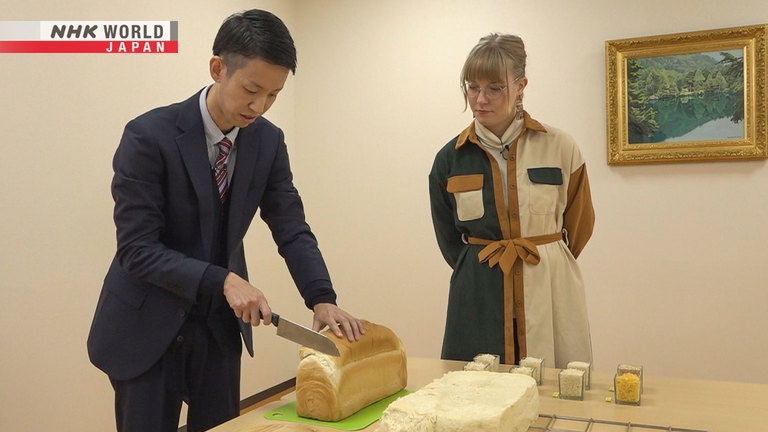PANKO
Known to the world as panko, Japanese breadcrumbs are made by breaking apart fresh loaves of bread. Experience Japan's crunchy, juicy and truly unique fried food culture. (Reporter: Kailene Falls)




Transcript
Tokyo: this world-class metropolis is a veritable gourmet wonderland.
Discover the stories behind the ingredients that make this city so delicious - so "oishii."
Let's talk about Japanese breadcrumbs, known as panko.
It's the key to making Japanese fried food so crunchy and delectable.
Fried pork cutlets known as tonkatsu, croquettes, fried shrimp, and more.
Panko's wide use in Japan has led to a unique culture of fried food.
So much in fact, the ingredient is now familiar overseas.
A European ingredient was reinvented in Japan.
Now that it's made a name for itself around the world,
discover production methods that have developed along the way.
Electrical baking?
How is panko influencing cuisine?
So good.
The food world has a new hero - panko!
Trails to Oishii Tokyo.
Hi, it's Kailene. When you visit Japan, what types of foods do you want to eat?
Sushi, ramen, maybe some "wagyu?"
A current trend in Japanese food is tonkatsu, or fried pork cutlets.
I grew up in the US, so I ate a lot of fried food growing up, yet I was surprised at Japanese fried food.
It's very light and crisp, and not oily.
I hear that the secret lies in the breading.
So today, let's learn about the secrets of Japanese panko.
Kailene begins in Kagurazaka, a lowkey historic area of central Tokyo.
Ah, I think we've found some panko.
So many.
There's a lot over here.
It's hard to choose.
She arrives at a meat shop that's been open around 70 years.
However, fried foods are more front and center.
They offer around 20 fried options for sale each day.
It's somewhat of a neighborhood institution - parents and kids always come back for more.
- What do you recommend?
- Shrimp cream croquettes.
And Scotch eggs.
- I was looking at those.
- They're big.
Nice. I haven't tried anything yet.
Just looking makes me drool.
Please buy something.
I will.
Everything's tasty.
When do you come here?
- When I'm too tired to cook.
- I see!
I use the fried pork cutlets
to make katsudon.
I say it's homemade, but it's this.
- Your secret is safe with me.
- Please.
One Scotch egg, please.
Kailene's got her eye on a few goodies.
A potato croquette.
"Itadakimasu."
We've got a really nice soft and somewhat sweet potato, but not just fried.
It's got the panko on the outside, so it adds an extra layer of crispiness.
It doesn't need anything in addition to this; it's beautiful as it is.
Now for the Scotch egg.
I can't describe how perfect the crunch on the outside of this is.
We've got the lovely egg, juicy meat, and then this crisp, light crunch on the outside. It's perfect.
Frying begins early in the morning.
They have to make tons - both for their shop and to fulfill orders from supermarkets.
They sell around 200 of these croquettes each day alone.
- Isn't this a meat shop?
- It is.
- It seems you mainly sell fried food.
- It turned out that way.
Loin meat is used
to make tonkatsu (fried pork cutlets).
Minced meat is also used for fried foods.
So, we started cooking the meat for customers.
Selling fried food became a way for meat shops to avoid wasting precious meat.
Panko was commercialized in the early 20th century.
After that, croquettes and other fried foods grew popular as use of panko spread beyond frying meats.
The shop uses 15 kilograms of panko each day.
Far from crummy, the pieces are big and moist.
They are deep-fried using plenty of lard.
Do you use a lot of lard?
About 15 kilograms.
We use three 15kg packs each day.
So, 45 kilograms in total.
Wow!
Actually, frying in large amounts of oil was a key factor in solidifying panko's influence on Japanese cuisine.
In the West, breadcrumbs are broken-up bits of dried bread or crackers.
The grains are typically small and dry.
In France and other parts of Europe,
veal was sprinkled with the crumbs and pan-fried in butter to make breaded meat cutlets.
When breadcrumbs came to Japan in the second half of the 19th century,
veal patties were seen as a symbol of Westernization,
but they were a bit too oily for Japanese tastes.
It's said a restaurant in Ginza, Tokyo, was the first to invent a recipe more suited to the Japanese palate.
Butter was replaced with large amounts of oil, making meat cutlets with a lighter and crispier texture.
This led to the creation of tonkatsu.
But its inspiration came from another famous Japanese food...
It was tempura!
Frying in large amounts of oil hardens the batter, locking in the flavor of ingredients.
Excess oil is removed, leaving a crispy outside and a juicy center.
Initially, panko was always handmade, each shop breaking apart fresh loaves of bread.
When fried, moisture is cooked out, creating air pockets in the batter.
This made the fried food crispier than the Western foods fried using drier breadcrumbs.
This is the origin story of panko.
In Matsudo, Chiba, Kailene heads to a restaurant that makes its own panko -
something that's become increasingly rare.
It's a tonkatsu joint established in 1972.
Here is your tonkatsu.
Amazing.
The panko texture is impressive.
Look at the panko on this.
I've never seen it this chunky before.
"Itadakimasu!"
Kailene begins with a bit of salt.
This has the most bready texture
of any tonkatsu I've ever eaten.
How do you make it so crispy?
I break up loaves of bread by hand.
By hand?
A loaf like this.
How many?
- I use around 20 loaves a day.
- 20?
He buys his panko bread from a nearby factory.
The crust is removed,
then the bread is simply pulled apart.
But it requires patience...
I don't think I've ever seen
loaves of bread pulled apart like this.
Bread has grains, just like wood.
I break it along the grains
to make pieces like this.
Quite long.
Forcefully pulling the bread apart like this
breaks the fibers and hardens the bread.
The pieces would hold too much oil.
I see.
- It's really like using bread as-is.
- Right.
Takahashi only makes what he needs for one day, because leftovers would dry up.
He says even with help from staff, it can take 10 hours total.
- I do this at night if needed.
- After hours?
I can do it while watching TV.
Well, you're doing it while talking to me,
so that makes sense.
- I've been doing it since I was a teen.
- Since that young?
- Yeah. I'm the second generation.
- Oh, I see.
His father, Takahashi Shusei, trained at a long-established tonkatsu restaurant in Shinjuku, Tokyo.
Then he opened this shop, where he continued to make panko by hand.
The Shinjuku location no longer exists.
The panko torch is now carried by his son, Hidenao.
Even when breading meat, he's careful not to crush the grains.
The lard mix is unique to the shop too.
The panko becomes crispy as moisture is cooked out.
Then, the meat is moved to a fresh batch of lard at a higher temperature.
This is a new step he added to his father's recipe to make the batter even crispier.
After frying, he gives it a good shake,
and props it up to let the oil drip off.
He offers a unique way to enjoy the perfectly-fried meat.
It's dipped into a mixture of soft-boiled egg and sweet sauce.
"Itadakimasu."
"Oishii."
Rich egg yolk and crisp panko.
What a lovely combination.
This panko is part of our identity.
I want to remain loyal to the original recipe.
A tradition handed down from father to son.
And passionate chefs continue to give panko new life.
Next, Kailene heads to Isesaki in Gunma.
She'll visit a panko company that handles the largest share of Japan's panko market.
During the high economic growth period in the mid-20th century,
demand for panko grew with the spread of frozen foods.
Panko companies popped up everywhere, and a race for technology began.
Let's see how panko is made nowadays.
This kneads dough.
Wow, I've never seen such a big mixer.
How much dough can it make?
330 loaves of bread in one go.
That's a lot.
I thought you'd make panko directly,
but you actually bake bread first?
Yes, we bake loaves first.
Amazing.
Panko begins with making the ideal bread.
Fermented dough is placed in molds and baked in a large oven.
A lovely aroma fills the room.
The bread is rising and
a nice crust is forming.
It smells great.
This method is called thermal baking.
And, yes, there's more than one method.
These look a bit different.
- These were done with electrical baking, not using heat.
- Electrical baking?
We've done this in Japan for a while now.
Electricity is passed through the bread.
- Completely white.
- Yeah, almost like it's steamed.
Bread made by electrical baking.
You can see the process here.
Let's take a closer look.
We put dough between two steel sheets
and run electricity through them.
The bread doesn't burn?
No. We add less salt to the dough
than when doing thermal baking.
That keeps the machine from short-circuiting.
So, electrically-baked bread has less salt.
Is this new technology?
It's been used by the Japanese military
since before World War II.
It began with a field kitchen developed by the Japanese army in prewar times.
It used electricity to cook rice and bread in war zones.
After the war, the technology entered the private sector,
and played a role in developing Japan's panko industry.
With electrical baking, bread doesn't form any crust.
For making certain types of panko, that's a big advantage.
The bread is baked, then broken a part.
The factory employs both thermal and electrical baking to produce a wide variety of panko.
By altering ingredients, crumb size, and moisture, they meet various customer needs,
from major frozen food companies to tonkatsu restaurants.
They currently make over 1,000 types of panko.
Let's take a look at the differing characteristics of thermal and electrical baking.
Kailene is invited to try some bread.
First up is thermal baked bread.
It has a bready texture, but with little flavor.
It has less sugar than standard bread.
Too much would burn it when fried as panko.
Sugar amount is adjusted based on frying time.
Thorough fermentation of dough makes panko from thermal baking nice and fluffy.
It gets good and crispy when fried, which is preferred by tonkatsu restaurants.
Cutting right into it.
This bread was done by electrical baking.
- A bit bland?
- No flavor.
Very little salt is used,
so there's little flavor.
But this is ideal for panko?
- Yes, this method is good for panko.
- Interesting.
Compared to thermal baking, electrical baking makes denser bread,
meaning the panko becomes firmer when fried.
Its crispy texture is longer lasting, which is ideal for take-out foods.
Drying this type of panko reveals another key point.
Dried panko soaks up moisture,
expanding usage beyond deep-frying.
It's often used at home to hold
hamburger meat together, for example.
Panko can also be dyed with natural coloring.
Fried foods can lose their color over time, but not if you use panko like this!
How about the brown panko?
That's recycled panko.
We buy crust from
bakers to make this type.
Major bread makers cut the crust off many loaves each day.
They used to be processed into feed, or thrown out.
But what a waste of flavor!
They were given a new life at panko factories.
Panko made from crust has a dark, richer flavor.
It's also affordable, making it popular with meat shops, delicatessens, and fried skewer restaurants.
Bread crust panko is now somewhat of a culinary staple.
It's good without sauce,
and has a nice bread flavor.
Using food that would have been
wasted is a great idea.
Right. Reuse ingredients
and give people tasty food to eat.
Japanese panko continues to evolve with the times.
And its evolution is influencing the world of gastronomy.
Kailene's final stop is Minami-asagaya, Tokyo.
She's heading to a famous tonkatsu restaurant that gets flooded with reservations even from overseas.
The restaurant actually uses custom panko from the factory Kailene visited.
Pork filet cutlet. Enjoy.
Amazing.
The meat is lighter in color than usual.
- Do I eat this as-is?
- Yes, try it without sauce.
"Itadakimasu."
Excellent.
The panko is crisp
but the meat is so tender.
It melts in the mouth.
I feel like I'm eating
tonkatsu for the first time.
- I fry it a bit differently.
- Unique cooking method?
He uses fat taken from pig mesentery arteries.
It holds heat better and leaves food crispy without being too oily.
Also, he uses very tender portions of filet meat,
and large grind panko from thermal baking.
Let's see what happens to the pure-white panko.
Into the fryer.
No bubbles or popping noise?
That's because the temperature is kept low, at around 110 degrees Celsius.
I put as little stress on the meat as possible.
The temperature is increased gradually.
Frying takes about 20 minutes this way.
Standard panko would burn.
His panko is made special, with very low sugar content.
Low sugar content minimizes fermentation.
The panko is made using cutting edge technology
resulting in a unique type that stays white even after 20 minutes of frying.
It'll rest here for 10 minutes.
The oil is still hot when it
comes out of the fryer.
- It doesn't cool as quickly as other fats.
- I see.
That residual heat cooks the meat
as the oil drips off.
The meat cooks slowly beneath the batter, coming out juicy and tender.
Meat is the main feature of tonkatsu,
but the batter is tasted first.
True.
In that sense, maybe panko
is more important.
First, you react to the tasty panko.
It melts away in the mouth.
Then, you enjoy the meat.
His passion for panko has led to an array of unique creations.
Time for dessert.
Dessert? What is it?
French toast.
I made it using this batter.
- The batter you used to make tonkatsu?
- Yes.
Leftover panko pieces are floating in the oil.
He'll use the savory, oily bits to make another dish.
"Itadakimasu."
- What a unique dessert. So good.
- Yeah? Great.
- How do you make it?
- I mix the fried bits with egg.
Because it's breadcrumbs mixed in egg,
the flavor is present throughout.
- Oh, it's not a batter for more toast.
- Right, not just batter over a surface.
Mix the fried pieces with egg, milk, and sugar - as easy as 1-2-3.
And since the panko came from a fryer, no additional oil is needed.
It's a sweet reminder that panko is essentially bread!
By making cakes, soups, and much more, Mitani continues to push the boundaries of panko.
You've inspired me
to experiment with panko.
- Great.
- This opened my eyes.
- Try making a fruit cutlet sandwich.
- Fried fruit sandwich? There we go!
Panko is bound to take our appetites to a whole new world.
I used to think of panko as a simple ingredient, almost an afterthought to the main dish.
And yet I now know that it plays such a vital role in Japanese comfort food, and boasts a surprising number of variations.
From the recipe of the bread itself, to the size and shape of the panko, to how the chefs prepare it,
Japanese panko really makes fried food light, crisp and delicious.
Of course, the possibilities of panko are endless.
It really plays a star in Japanese fried food.
In Tokyo, every ingredient has its own story.